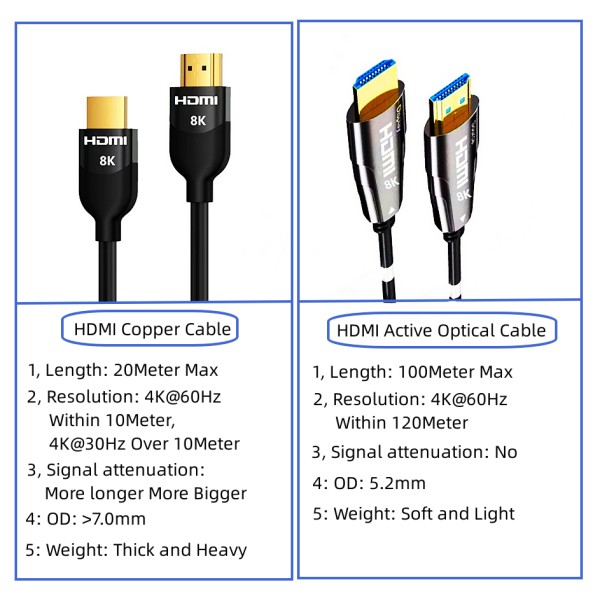HDMI ACTIVE OPTICAL CABLE vs HDMI TRADITIONAL COPPER-CORE CABLE
The Characteristic of HDMI Active Optical (AOC) Cables
In recent years, technology breakthroughs in the audio and video transmission industry have continued, and HDMI high-definition cables have evolved from traditional HDMI copper-core cables to HDMI Active Optical (AOC) Cables. Since traditional the former cannot achieve stable transmission over long distances, more and more people are HDMI Active Optical (AOC)Cables.
Do you have any idea what the principle of audio and video transmission is?
Today’s article is aiming at enriching your understanding of HDMI Active Optical (AOC) Cables concerning its birth, advantages, and application. Also, the difference between traditional HDMI copper-core cables and HDMI Active Optical (AOC) Cables would be mentioned, hoping to provide some sources for your findings.
First, let’s start with: what are HDMI Active Optical (AOC) cables?
What Are HDMI Active Optical (AOC) Cables?
HDMI AOC Cables are a cabling technology that accepts the same electrical inputs as a traditional copper cable, with the application of optical fiber as the transmission material “between the connectors”.
The AOC Cable uses electrical-to-optical and integrates the photoelectric conversion on the cable ends to improve speed and distance performance of the cable without sacrificing compatibility with standard electrical interfaces.
Before moving on, you should have a brief understanding of the traditional HDMI copper-core cables to better catch up with the benefit with HDMI Active Optical Cables.
The Limitation of Traditional Copper-core Cables Technology
InfiniBand technology was the inventor of HDMI AOC (Active Optical) cables, under the situation that copper cable technology is getting stretched to its limits with InfiniBand ‘s data rates rising data center clusters growing.
Imagine that Double Data Rate (DDR) of 20 Gigabits per second (Gbps) with the usage of conventional copper cable is limited to an 8 to 10-meter reach, which may be fine for small clusters, but would be a great challenge for larger clusters’ physical layout with the limitation of physical link distance.
With the unchangeable bandwidth-distance limitations of copper cable assemblies, it is common for designers to embed amplifiers, signal regenerators, or similar devices within a cable assembly.
Other than that, the copper-core cable is heavy and bulky, making it hard to physically manage the datacenter. And due to the nature of electrical signals, electromagnetic interference (EMI) limits copper-core cable’s performance and reliability.
The idea of HDMI AOC Cable is to convert the high-speed digital signal, such as HDMI/DP/USB, into an optical signal, as the traditional copper cable has limitations on transmission distance due to its natural physical properties.
Theoretically, the bandwidth can be increased without limitation and there is no signal attenuation over longer distances. It creates greater possibilities of applications for HDMI/DP/USB etc.
The Advantages of HDMI AOC Cables Compared to the Traditional HDMI Copper-core Cables
HDMI AOC cables were designed to fix the inherent limitation of traditional HDMI copper-core Cables, whose development has a tremendously positive effect on the audio and video transmission industry and the application into the various fields.
Signal Further Carried and Lower Risk of EMI/RFI Interference
For traditional HDMI Copper-core cables, there will be a certain loss when long-distance transmission reaches more than 10 meters. Thus you can realize the many benefits of optical fiber as a core when the long-distance signal transmission is needed.
HDMI AOC cables rely on fiber optic technology to transport the digital HDMI signal, which means it can carry the signal much further than traditional copper cables (up to 100 m). Also, with the usage of fiber optic technology, AOC cables also do well in reducing the risk of EMI/RFI in high interference environments.
No external Power Supply needed
HDMI AOC cables have dedicated copper power wires inside to guarantee lower power consumption, which means the external power supply is no longer required.
Using optical fiber, the data stability is excellent, and the power consumption can be extremely low: 45mA, far lower than the 55mA required by the HDMI specification. The outer diameter of the wire can be the only 4.0mm, which is very suitable for installation in narrow spaces. Therefore, the AOC cable can be widely used in home theaters, medical equipment, factory automation, public display occasions, and installations.
Smaller Size and Lower Weight
HDMI AOC cables have smaller cable diameter compared to traditional copper HDMI cables, and durable extra thin premium quality braided cable is available with stylish metal connectors, making it easier to the physical data center management.
To sum up, AOC Cables have the advantages of long-distance transmission, 300 meters to 4K HD achievement, easy to use, no impedance, no signal loss, strong stability, no combination of electromagnetic interference. Abundant purchases of HDMI optical fiber lines are due to these characteristics.
The Application of HDMI AOC Cables
Not surprisingly, nowadays, the application of high-definition video is becoming increasingly becoming popular, no matter it’s about personal mobile phones, commercial screens, industrial or medical. Also, a bit suitable for engineering use. For most projects, construction units, conference rooms, and other environments, it is particularly appropriate to use.
More and more scenarios couldn’t be put into effect without HDMI AOC cables application requirements, and we also believe HDMI AOC cables will be able to offer even more applications with the arrival of 5G.
HDMI Copper Cable VS HDMI Active Optical Cable



